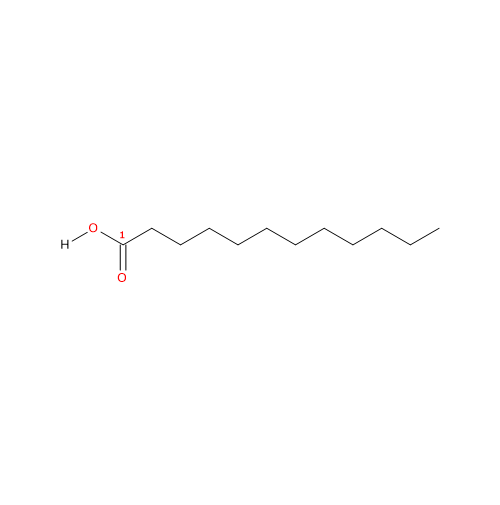Lauric acid (12 carbon atoms) was discovered by Marsson T. in 1842 in the seeds of Laurus nobilis, from which its name.
It belongs to the group of saturated fatty acids since there is no double bond in the aliphatic chain, so its shorthand notation is 12:0. It is a member of the sub-group called medium chain fatty acids or MCFA, namely fatty acids containing from 6 to 12 carbon atoms.
PROPERTIES
Molecular weight: 200.31776 g/mol
Molecular formula: C12H24O2
IUPAC name: dodecanoic acid
CAS registry number: 143-07-7
PubChem: 3893

In purified form it is a white crystalline powder insoluble in water, with melting point at 44-44.2 °C (111.2-111.56 °F; 317.15-317.35 K) also reported as 48 °C(118.4 °F; 321.15 K) and boiling point at 225 °C (437 °F; 498.15 K) at 100 mmHg or 298.9 °C (570.02 °F; 572.05 K) at 760 mm Hg.
It has a faint odor of baby oil or soap and is used in many soaps and shampoos in the form of sodium lauryl sulfate.
OTHER NAMES
n-dodecanoic acid
duodecylic acid
dodecylic acid
dodecoic acid
vulvic acid
laurostearic acid
dodecylcarboxylate
1-undecanecarboxylic acid
12:0
Food sources of lauric acid
Lauric acid, as glycerol ester, is found in high amount in some tropical oils.
It is present in high quantity in coconut oil and palm kernel oil, approximately 45 g/100 g edible portion.
It should be noted that palm kernel oil is extracted from the seeds of oil palms, while palm oil from the pulp of the fruit of oil palms.
In the other vegetable fats and oils, tropical or not, such as extra virgin olive oil, corn oil, palm oil, soy oil, sesame oil, margarine, peanut butter, and so on, it is absent or present in low amount (e.g., margarine, 0.76 g/100 g edible portion).
It is also virtually absent in the fat of red and white meat, eggs, and fish products. Small amounts are found in the lard, 0.23 g, and smoked eel, 0.28/g/100 g edible portion.
It is present in low concentrations, <2.5 g/100 g edible portion, in milk and dairy products (the highest content is found in butter, 2.4 g/100 g edible portion).
In fruit, it is abundant only in coconut, both fresh and dried, with respectively 16 g and 29 g/100 g edible portion. It is not present in the other fruit.
It is not found in cereals and legumes.
References
- Akoh C.C. and Min D.B. “Food lipids: chemistry, nutrition, and biotechnology” 3th ed. 2008
- Chow Ching K. “Fatty acids in foods and their health implication” 3th ed. 2008